Encouraging students with lectures focused on fields of business.
Photo lessons and other activities, plus regular classes.
We held our interview with Mr. Ohki at the Institute of Industrial Science, University of Tokyo and invited Professor Kazuo Kuroda to join the discussion. Professor Kuroda is in charge of the Nikon Chair of Optical Engineering representing the University of Tokyo.
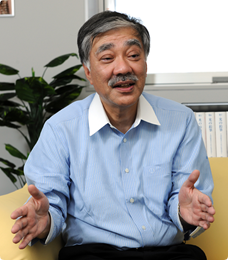
Professor Kazuo Kuroda, Institute of Industrial Science, University of Tokyo
How have the students responded?
Kuroda: Most other lectures use projectors or blackboards, and tend to be one-sided. The Nikon Chair, on the other hand, allows students to participate in actual practice. Our students seem to like it. What’s more, the practice is directly focused on business in the market. For most students, this experience is quite new, and very different from other classes.
What’s the format of your lesson?
Ohki: At the start, I give the students a slide show explaining the fundamental knowledge of optics. After this, I show them a problem that looks extremely complicated and that they won’t be able to find the solution to. This produces a kind of surprise impact. (Laugh) This is my style and logic for conducting my lessons.
Please give us an example.
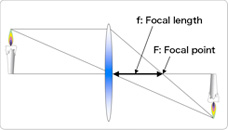
Diagram 1: Basics of image formation
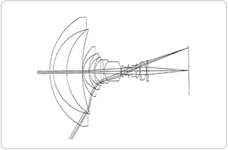
Diagram 2: What’s the focal length of this lens system?
Ohki: Students may remember a science textbook from their high school days — in which a candle and a lens are placed as you see in Diagram 1. They may recall what the image of the candle looks like through the lens. This is where I start the lecture. It’s as simple as that. Students are confident that they know it correctly. Then, I show them multiple optical paths with multiple lenses, as in Diagram 2, and ask the students what the focal length is of this lens system. So far, no students have dared to try and answer the question. In fact, the solution can be calculated merely by using a ruler. It is as simple as that. I explain this to the students. They seem to find it a great discovery. I can see, from this point of the session on, that the students are becoming rapidly absorbed in the topics of our discussion.
Tell us about your lens design training lesson.
Ohki: I let our students practice a simple design of a lens, while teaching them how to use lens design software, as well as instructing them about basic rules and principles of spherical and chromatic aberrations. After this, I give them a hard copy of computer-simulated images created by lenses of their own designs. They can observe and confirm the possible results of their works. It seems they now understand how complicated it is to design the gigantic groups of lenses used for IC steppers; or zoom lens systems composed of tens of lenses that are employed with SLR cameras.
So, the Nikon Chair of Optical Engineering is making a great contribution, is it not?
Kuroda: Yes, it is. The gap has been growing wider recently between the talent and educational level of the people that the industry needs and those that the universities can provide at their laboratories. This tendency is said to be true, not only for the industry of optics, but also in key industries such as steel. Our trial with this Nikon Chair is the first of its kind, and very significant for the future development of academia-industry joint research activities. Mr. Ohki is a highly creative planner with unique ideas, who never confines his energy to lectures alone. We look forward very much to his extensive contribution in the future.
What kind of unique planning does he offer?
Ohki: For example, the Nikon Chair invites instructors from Nikon College at Nikon Imaging Japan Inc. to give lessons on photography. The class also provides a special photographic session where students shoot small objects on a table, which helps them train themselves to take clean pictures of devices or crystals for their research papers. Students love this class and it’s packed full in an instant every time the class starts recruiting.
Kuroda: I myself have learned a lot from the project. Now I know how I can take the photos I want. Photography is now a big hobby of mine.
Mr. Ohki, Professor Kuroda has been your close partner for more than 30 years.
Ohki: Yes. It was at the end of 1984 when we first met at a research conference held by Ogura and Kuroda Laboratory. The conference was open to every researcher, even accepting participation from private enterprises. It was regularly held every Tuesday, and hence given the name Kayo Rinkokai or Tuesday Seminar.
Kuroda: Oh yes, now I remember, when Mr. Ohki first came to the meeting, being introduced as a man of many hobbies. (Laugh)
What kind of hobbies are they?
Ohki: They are just hobbies. Here’s one example. I tried writing my own style of novels in my childhood. I admit it may have seemed a little strange at the time. But when I had read a novel, I was often motivated to write my own, with a similar story to the book I had just finished. I also wrote a comic book. I continued writing even after I grew up, and was awarded a prize for a novel.
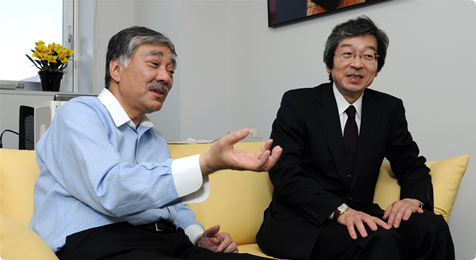
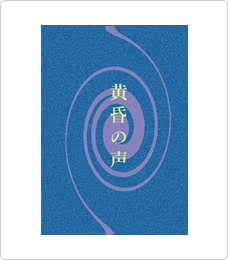
Awarded the prize of excellence by 100-yen Pocketbook Online Grand Prix, 2001.
